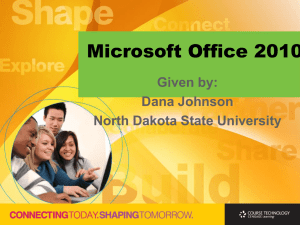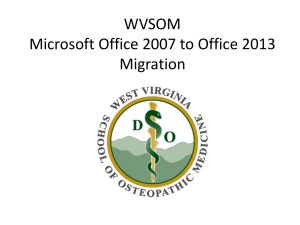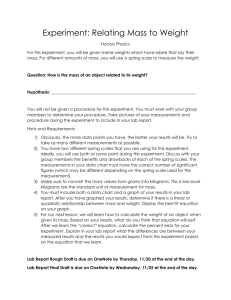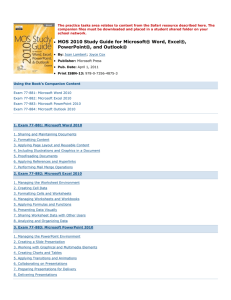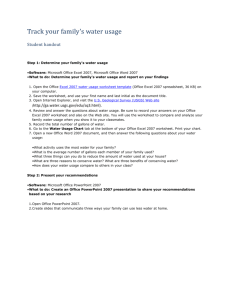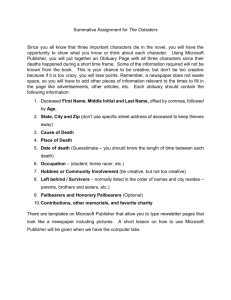File - SEHS Business Management & Administration
advertisement
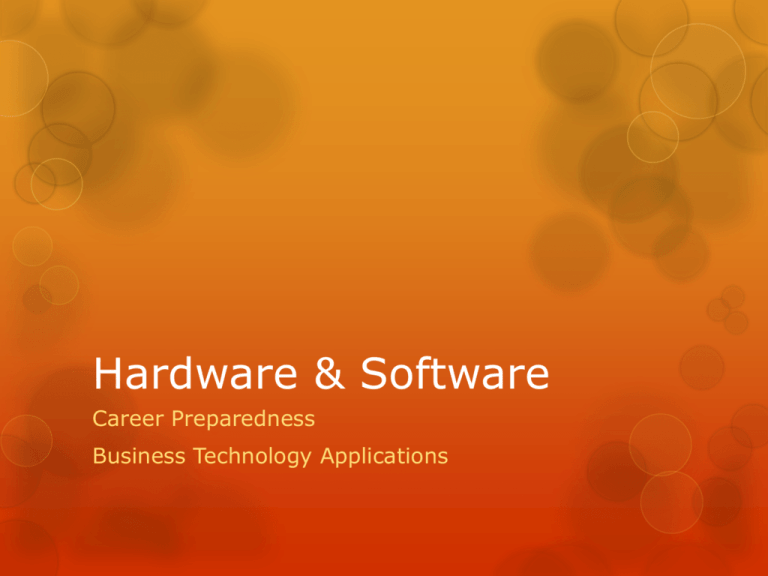
Hardware & Software Career Preparedness Business Technology Applications Computer http://www.youtube.com/v/7cXEOWAStq4?auto play=1&iv_load_policy=3&fs=1 What is a computer? A computer is an electronic device that when given instructions accepts data, processes data, and produces output that is useful information. Data is raw facts given to a computer during input. Information is data that has been processed. Components of the Personal Computer Input – data used by the computer Information Processing Cycle Input Processor Memory/ Storage Output Information Processing Cycle Input Processor Memory/ Storage Output Instructions Information Processing Cycle Input Processor Accepts data Memory/ Storage Output Instructions Information Processing Cycle Input Processes data Processor Accepts data Memory/ Storage Output Instructions Information Processing Cycle Input Processes data Processor Accepts data Memory/ Storage Instructions Output Useful information Memory RAM – Random Access Memory -where we work -data is lost w/out power Input Memory/ Storage Processor Output ROM – Read Only Memory -permanent memory -holds software Cache Memory Cash extremely fast stores repeatedly required instructions improving overall system speed Information Processing Cycle The computer uses a combination of hardware and software to carry out the information processing cycle. Different Types of Computers Desktop Work, home, school, library Easy to upgrade and exand Cost: Less expensive than laptop Keyboard for typing Mouse for navigation Laptop Battery or AC powered More portable than desktop Not as easily upgradaded Touchpad for navigation instead of mouse Tablet Handheld More portable than laptop Touch-sensitive screen instead of keyboard/mouse for typing and navigation Servers Computer that serves up information to other computers on a network. Can look like a desktop or be much larger Where Internet webpages are stored Specialized Computers Mobile phones/smart phones Game console TVs Hardware vs. Software Hardware Software Any part of the computer that has physical structure A set of instructions that tells the hardware what to do. Ex: keyboard/mouse, internal parts Guides the hardware and tells it how to accomplish tasks. Ex: web browsers, games, word processors Everything you do on your computer will require both hardware and software. HARDWARE Input Output Processor Peripheral Keyboard Mouse Microphone Scanner Monitor Speakers Printer Motherboard CPU (microchip) Speakers Microphone Etc. SOFTWARE Software Term that describes computer programs. Instructions for the computer. Types of Software Application Software Utility Software Operating System Software Types of Software Application Software Utility Software Fundamental -Needed to boot up -every computer> desktop, laptop, tablet, cell phone has an OS -provides a GUI – graphical user interface Ex: Windows, Mac OS X Operating System Software Types of Software Application Software Utility Software Fundamental -Needed to boot up -every computer> desktop, laptop, tablet, cell phone has an OS -provides a GUI – graphical user interface Ex: Windows, Mac OS X Operating System Software -Maintains, manages, and protects system -keeps computer running smoothly Examples: -backup/update -Security (virus/spyware) - Spam/Pop-up Blocker - Screensaver, Themes, Wallpaper - Adobe Flash Player -End user software -each is specific Examples: -Word -Excel -PowerPoint Types of Software Fundamental -Needed to boot up -every computer> desktop, laptop, tablet, cell phone has an OS -provides a GUI – graphical user interface Ex: Windows, Mac OS X Application Software Utility Software Operating System Software -Maintains, manages, and protects system -keeps computer running smoothly Examples: -backup/update -Security (virus/spyware) - Spam/Pop-up Blocker - Screensaver, Themes, Wallpaper - Adobe Flash Player More About the Operating System http://www.gcflearnfree.org/computerbasics/2 Software Suite Word Excel PowerPoint Microsoft Office Outlook OneNote Publisher Access Software Suite Word Excel PowerPoint Microsoft Office Outlook OneNote Publisher Access Word processor Software Suite Word Excel PowerPoint Microsoft Office Outlook OneNote Publisher Access Spreadsheet application Create charts and graphs Software Suite Word Excel PowerPoint Microsoft Office Outlook OneNote Publisher Access Presentation application Software Suite Word Excel PowerPoint Microsoft Office Outlook OneNote Publisher Access Email, calendar, tasks Software Suite Word Excel PowerPoint Microsoft Office Outlook OneNote Publisher Access Digital notebook: single place to gather notes and information Software Suite Word Excel PowerPoint Microsoft Office Outlook OneNote Flyers, Publisher brochures, Etc. Access Software Suite Word Excel PowerPoint Microsoft Office Outlook OneNote Publisher Access Database, Reports, tables Storage Size & Processor Speeds Bits, Bytes, & hertz Storage & Memory Smallest unit of data used by a computer Bit Binary digit 0 or 1 Byte 8 bits 1 Byte is equal to one character. Kilobyte 1,000 Bytes 1 KB = 1 paragraph Megabyte 1,000 Kilobytes 100 MB = 2 volumes of encyclopedia Gigabyte 1,000 Megabytes Common term when referring to disk space or drive storage Terabyte 1,000 GB One trillion Bytes 300 hours of video Clock Speed The speed of a computer’s CPU a measure of how quickly a computer completes basic computations and operations. Cycles per second Measured in hertz (Hz) One cycle per second is one hertz. Measured in megahertz (MHz) and gigahertz (GHz) NETWORKS Network Basics Consist of servers and clients Protocol – the language that computers use to talk to each other. http – hypertext transfer protocol Used in web browsers and web servers Local Area Network (LAN) Geographically small Tied to one building or site Use cables or low-power radio to connect Wireless Local Area Network (WLAN) LAN that uses radio signals (WiFi) to connect computers Wireless switch or router at the center Small box with one or two antennas Sends and receives data Difficult to secure Legal Aspects Wide Area Network (WAN) Extends over a large area Often joins several LANs together Links between computers are over long distances Connect through optical fiber cables, satellite radio links, microwave radio links The Internet is a global WAN Bluetooth (Personal Area Network) Wireless technology for shortrange connections Eliminates need for USB cables that connect computer to peripherals Contain low-power radio transmitters and receivers Examples: Wireless keyboard or mouse Wireless headset with cell phone IP and ISP Who provides the connection? Internet Service Providers provide the hardware like cables and fiber optics. Examples? How are individual clients/computers identified in a network? IP Address Internet Protocol address What’s yours? The Internet The Internet Early days: used to search for information Today: constantly evolving tool that provides new ways of accessing, interacting, and connecting with people and content What is it exactly? The largest computer network in the world. Client requests data from the server using web browser Server sends data to client Server processes request World Wide Web Internet and World Wide Web are used interchangeably, but are not the same thing! Internet is the physical network of computers all over the world. World Wide Web is a virtual network of websites connected by hyperlinks (links) Websites are stored on servers on the Internet, so the world wide web is a part of the Internet HTML The backbone of the World Wide Web: HTML files Specially formatted documents that can contain links, images, or other media. All web browsers can read HTML Files URL Uniform Resource Locator (URL): The web address For example: www.sehsfbla.weebly.com www.mysehs.com www.sehsbusinessmgt.weebly.com Did You Know? The World Wide Web was created in 1989 by Tim Berners-Lee, a software engineer. Before then, computers could communicate over the Internet, but there were no web pages. The Internet began in 1969 when the US Dept of Defense created ARPAnet, a project to allow military personnel to communicate in an emergency. By 2012, there were 2.4 billion internet users (1/3 the earth’s population) To store all the information available on the Internet, you would need 1 Billion DVDs or 200 Million Blu-ray discs! Finding Information Online Search engine Finding information online Google Intelligent personal assistants Siri Using the Internet to Communicate Social networking/social media Facebook Twitter Instagram linkedIn Chat and Instant messaging Yahoo! Messenger Facebook VoIP – Voice over Internet Protocol Telephone service through Internet connection Skype FaceTime Blogs Shape the Internet by adding to it Share your thoughts Blogger.com Wordpress.com Simple Network • two computers make a direct connection with each other and communicate across a wire or cable. • have existed for decades. • common use is file sharing. Local Area Network • group of computers located in a home, school, or part of an office building. • share files and printers. • can share connections with other LANs and with the Internet Wide Area Network • Wide area networks cover a large geographic area like a city, a country or multiple countries. • normally connect multiple LANs and other smaller-scale area networks. • built by large telecommunication companies and other corporations using highlyspecialized equipment not found in consumer stores • The Internet is an example of a WAN that joins local and metropolitan area networks across most of the world. Wired Computer Networks • twisted-pair Ethernet cables are often used to connect computers. • Phone or cable TV lines in turn connect the LAN to the Internet Service Provider (ISP). • ISPs use a mix of different kinds of cable to join this equipment to LANs and the Internet. • Much of the Internet uses high-speed fiber optic cable to send traffic long distances underground, but twisted pair and coaxial cable can also be used for leased lines and in more remote areas.
